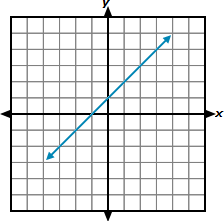A linear function can be represented by an equation, table, or graph.
A linear function can be represented by an equation in the form y = mx + b, where m is the slope and b is the y-intercept.
Values can be substituted into the equation for x to find the corresponding y-values of points on the line.
These values can be written in an x,y table or as coordinate pairs.
First, substitute values for
x into the equation and simplify.
| x = -2 | | y = 3(-2) - 1 = -7 |
| x = -1 | | y = 3(-1) - 1 = -4 |
| x = 0 | | y = 3(0) - 1 = -1 |
| x = 1 | | y = 3(1) - 1 = 2 |
| x = 2 | | y = 3(2) - 1 = 5 |
| x = 3 | | y = 3(3) - 1 = 8 |
Then, make an
x,
y table using the
x- and
y-values.
| x | y |
| -2 | -7 |
| -1 | -4 |
| 0 | -1 |
| 1 | 2 |
| 2 | 5 |
| 3 | 8 |
First, plot the points (-2, -7), (-1, -4), (0, -1), (1, 2), (2, 5), and (3, 8) on a coordinate plane.
Then, connect the points to form a line.


 7th Grade Math - Linear Representations Lesson
7th Grade Math - Linear Representations Lesson




